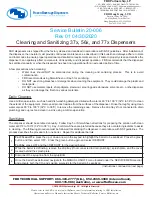
Stainless Steel Care & Maintenance
All grades of stainless steel will stain and discolour due to surface deposits and
cannot be considered completely maintenance-free. In order to retain
maximum corrosion resistance and aesthe c appeal, the surface of stainless
steel must be kept clean. Cleaning schedules should be carried out on a
regular basis then good performance and long service life are assured.
GENERAL CLEANING METHODS
Stainless steel is easy to clean. Washing with soap or a mild detergent and
warm water, followed by a clear water rinse, is usually quite adequate for
domes c and architectural equipment. An enhanced aesthe c appearance will
be achieved if the cleaned surface is wiped dry. Where stainless steel has
become extremely dirty with signs of surface discoloura on, (perhaps
following a period of neglect or misuse), methods of cleaning are detailed in
the chart provided below:-
Requirement
Suggested Method
Comments
Rou ne cleaning of
light soiling
Soap, detergent or dilute (1%)
ammonia solu on in warm clean
water. Apply with a clean sponge, so
cloth or so - fibre brush then rinse in
clean water and dry.
Sa sfactory on most
surfaces
Fingerprints
Detergent and warm water,
alterna vely, hydrocarbon solvent
Proprietary spray-applied
polishes available to
clean and minimise
remarking
Stubborn spots,
stains and light
discoloura on
Mild, non-scratching creams and
polishes. Apply with so cloth or so
sponge andrinse off residues with
clean water and dry
Avoid cleaning pastes with
abrasive addi ons. Do not
use chloride solu ons
Water marking. Light
rust staining
rinse off residues with clean water and
dry
Hea ng or heavy
discoloura on
Nylon-type pad, e.g. ‘Scotchbrite’
Use on brushed and
polished finishes along
the grain.
May brighten dull finishes
To avoid a patchy
appearance, the whole
surface may need to be
treated
Paint, graffi
Proprietary alkaline or solvent paint
strippers, depending upon paint type.
Use so nylon or bristle brush on
pa erned surfaces
Apply as directed by
manufacturer
Badly neglected
surfaces with
accumulated grime
deposits
A fine, abrasive paste as used for car
body refinishing, e.g. ‘T-cut’ rinsed
clean to remove all paste material &
dried
FACTORS AFFECTING MAINTENANCE
Surface contamina on and the forma on of deposits must be prevented. These
deposits may be minute par cles of iron or rust from other sources used in the
building of new premises and not removed un l a er the stainless steel items
have been fixed. Industrial and even naturally occurring atmospheric condi ons
can cause deposits that can be equally corrosive, e.g. salt deposits from marine
condi ons. A working environment which offers more aggressive condi ons, e.g.
hot & humid, such as in a swimming pool, increases the speed of discoloura on
and therefore requires maintenance on a more frequent basis. Modern
processes use many cleaners, sterilisers and bleaches for hygienic purposes. All
these proprietary solu ons, when used in accordance with makers' instruc ons,
are safe, but if used incorrectly (e.g. warm or concentrated), can cause
discoloura on and corrosion on the surface of any quality of stainless steel.
Strong acid solu ons are some mes used to clean masonry and ling of
buildings but they should never be permi ed to come into contact with metals,
including stainless steel. If this should happen, the acid solu on must be
removed immediately by copious applica ons of water.
BRUSHED STAINLESS STEEL
When the steel has become extremely dirty, perhaps following periods of
neglect or a er being subjected to a par cularly aggressive environment, mild
abrasion only (such as scrubbing with a nylon or other non- scratching scourer)
may be necessary. Ordinary steel wool soap pads should never be used as they
may leave par cles of mild steel on the surface of the stainless steel, which may
cause localised areas of rus ng. Stainless steel soap pads, are quite suitable.
POLISHED STAINLESS STEEL
A highly polished surface will be permanently marked by the use of abrasives
which, therefore, should be avoided at all costs. Discoloura on, heavy dirty or
rust which may resist normal cleaning methods can be removed using a
proprietary stainless steel cleaner followed by a clear water rinse. Some
deposits and stains encountered in catering and medical applica ons can be
difficult to remove. It should be noted that nearly all abrasive cleaners will
scratch a bright annealed or 2B finish of stainless steel. On other finishes the
cleaner should be used in the direc on of the polish. A clean dust and grit-free
cloth should be used to avoid scratching. In all cases the mildest cleaning
procedure that will do the job efficiently should be used.
P3
P2
POWDER COATED STEEL
Carefully remove any loose deposits with a wet cloth.
Use a so cloth and a mild household detergent solu on to remove dust, salt
and other deposits.
Rinse off with clean fresh water.




















